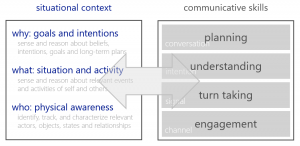The situated interaction research effort aims to enable computers to reason more deeply about their surroundings, and engage in fluid interaction with humans in physically situated settings. When people interact with each other, they engage in a rich, highly coordinated, mixed-initiative process, regulated through both verbal and non-verbal channels. In contrast, while their perceptual abilities are improving, computers are still unaware of their physical surroundings and of the “physics” of human interaction. Current human-computer interaction models assume there is a single user, engaging with full attention on a single computer system. Computers do not yet understand engagement, attention, proximity, interruptability, turn-taking, group dynamics, social expectations, human memory and goals, and so on. Our research aims to address these challenges and create the basis for a new generation of situated systems that are capable of fluid interactions and collaborations with people.
A primary research area for our group is situated language interaction. Historically, a lot of focus in the dialog community has been on speech recognition and dialog control. In physically situated settings, robots and virtual agents require several additional competencies. Interactions in the open-world typically involve multiple participants; people who come and go, and interleaved interactions with each other and the system. Situated systems therefore need to regulate attention and conversational engagement. Similarly, simple turn-taking models like “you speak, then I speak” need to evolve into more sophisticated multi-party turn-taking models. At the higher levels, the actions of others (whether verbal, non-verbal, or physical) need to be understood within the broader situational context and the systems need to continuously coordinate their own actions with the actions of all the other participants.
In our work, we develop computational models for situated communicative processes anchored into reasoning about the surrounding context. The work ranges from developing representations (for example, what are key variables for reasoning about turn-taking in a multiparty conversation?) to constructing inference models (for example, who will start talking next?) to decision making (for example, should I start talking now?) and all the way to execution (for example, how should I say this. given what everyone else is doing?).

-
Leah Perlmutter
Zhou Yu
Sean Andrist
Shray Bansal
Oriol Vinyals
Stephanie Rosenthal
Richard Roberts
William Wang
Walter Lasecki
People
Research Team
Sean Andrist
Senior Researcher
Dan Bohus
Senior Principal Researcher
Eric Horvitz
Chief Scientific Officer
Nick Saw
Principal Research Software Engineer
Andy Wilson
Partner Researcher
Alumni
Anne Loomis Thompson
Principal Research Software Engineer

